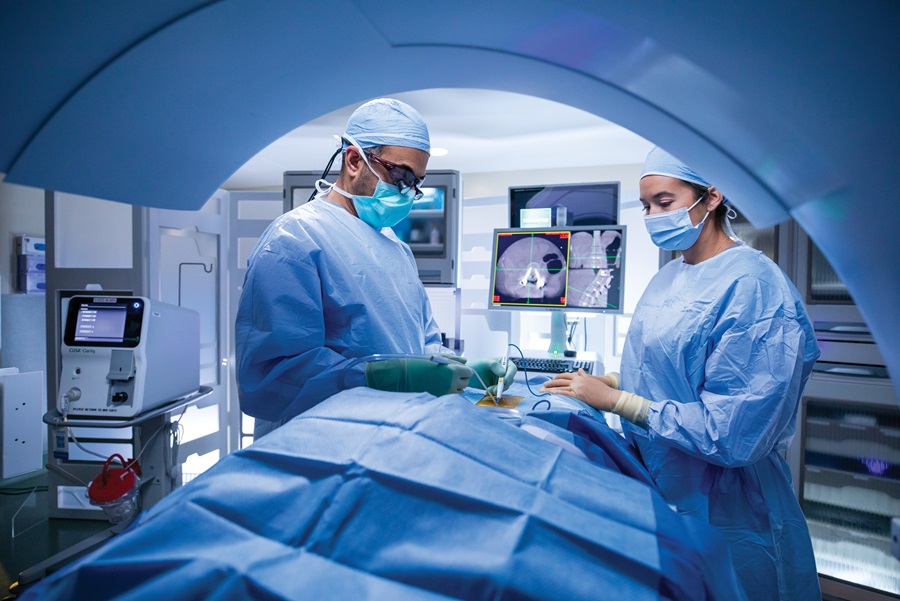An Overview of Back Conditions That Frequently Cause Surgical Treatments
Spinal column problems such as herniated discs, back stenosis, and degenerative disc illness frequently necessitate medical interventions when conservative therapies stop working to minimize persistent signs. Understanding the nuances of each problem and the equivalent medical choices, such as discectomy or spinal blend, is critical for efficient management.
Herniated Discs
Although numerous individuals with herniated discs may discover alleviation via traditional treatments, surgery ends up being a necessary consideration when signs get worse or linger - best spine surgeons in st louis mo. A herniated disc happens when the soft inner gel of a spinal disc extends through its external layer, possibly leading and compressing nearby nerves to discomfort, feeling numb, or weakness in the extremities
Traditional management usually includes physical therapy, discomfort medicines, and corticosteroid injections, which intend to reduce swelling and enhance feature. In situations where these approaches stop working to reduce devastating signs, surgical alternatives may be explored.
The most common operation for herniated discs is a discectomy, which entails the elimination of the herniated section of the disc to relieve pressure on the impacted nerve origin. In extra serious cases, spine combination may be necessary to stabilize the affected vertebrae.
Clients are advised to talk about the prospective risks and advantages of surgical procedure with their doctor to make an informed choice. Ultimately, the goal of any surgical treatment is to recover function, relieve discomfort, and improve general quality of life for individuals suffering from herniated discs.
Back Constriction
Spine stenosis occurs when the rooms within the spine slim, bring about enhanced pressure on the spine and nerves. This problem can develop in various areas of the spine, including the cervical and back locations, commonly as a result of age-related adjustments, such as degenerative disc condition, joint inflammation, or enlarging of ligaments.
Individuals with spine constriction might offer with signs and symptoms that include pain, pins and needles, tingling, or weakness, largely in the arms or legs. These signs and symptoms can be exacerbated by tasks that include standing or strolling, frequently leading individuals to look for alleviation through conservative therapies like physical therapy, medications, or epidural steroid shots.
Nonetheless, when these non-surgical treatments stop working to supply adequate alleviation, surgical choices may be considered. Usual medical procedures for spine stenosis consist of laminectomy, which entails the removal of component of the vertebra to reduce stress, and spine fusion, which stabilizes the affected area.
Spondylolisthesis
Spondylolisthesis happens when one vertebra slides forward over an additional, causing misalignment of the spine. This problem can arise from various aspects, including hereditary flaws, injury, or degenerative adjustments in the back. It is most generally observed in the lumbar other area, particularly at the L4-L5 and L5-S1 degrees.

Therapy choices differ based on the extent of the slippage and the signs provided. Conservative actions, consisting of physical treatment, discomfort administration, and task modification, are commonly the very first line of protection. When non-surgical techniques fail to eliminate signs and symptoms or when substantial nerve compression is existing, surgical intervention may be necessitated. Surgical choices can consist of spine fusion or decompression treatments, targeted at bring back positioning and minimizing neurological symptoms. Early medical diagnosis and appropriate management are important for optimum end results in patients with spondylolisthesis.
Degenerative Disc Illness

People with DDD typically experience pain that may radiate to the arms or legs, depending on the affected area of the spinal column. The condition can be detected via a mix of professional assessment, imaging studies, and individual background. Treatment choices generally start with conservative actions, including physical therapy, discomfort monitoring, and lifestyle adjustments. When these approaches stop working to give sufficient alleviation, medical treatments may be thought about.
Surgical choices for DDD may include spinal blend or synthetic disc i was reading this substitute, intended at stabilizing the affected sector and relieving pain (best spine surgeons in st louis mo). Inevitably, the choice of therapy is embellished, taking into consideration the severity of the condition, individual health and wellness, and way of living factors
Spinal Lumps

Spinal growths can emerge from different elements, including genetic tendency, environmental impacts, and pre-existing clinical conditions. Clients may offer with a variety of signs and symptoms, including local pain, neurological deficits, weakness, or adjustments in bowel and bladder function, depending on the tumor's size and location.
Surgical intervention might be required to minimize symptoms, obtain a biopsy, or remove the tumor totally. The goal of surgical treatment is frequently to decompress neural aspects and stabilize the back. Early discovery and treatment are crucial for enhancing end results in patients with spine tumors.
Conclusion
In summary, back conditions such as herniated discs, back constriction, spondylolisthesis, degenerative disc condition, and spinal tumors often necessitate medical treatment as a result of their prospective to cause substantial discomfort and useful problems. While traditional therapies might use short-term alleviation, medical alternatives become essential when signs worsen or linger. Timely medical diagnosis and treatment play a crucial role in bring back function and enhancing the lifestyle for afflicted people, emphasizing the relevance of thorough back treatment.

Comments on “How to Plan for Visits to the Best Spine Surgeons in St Louis MO”